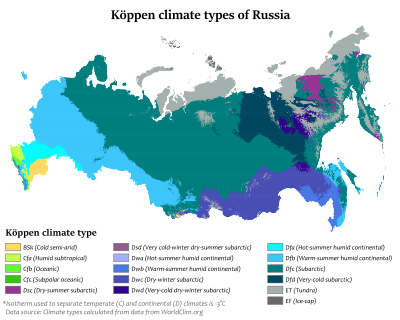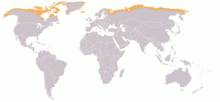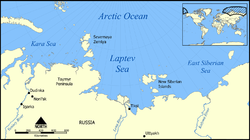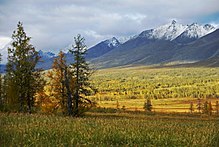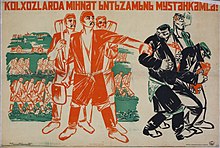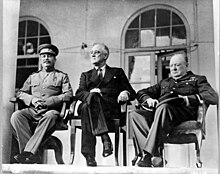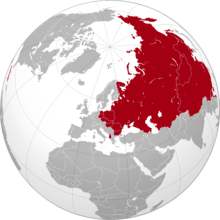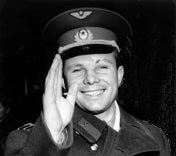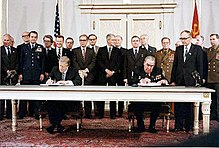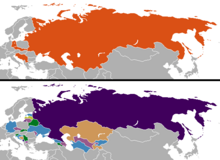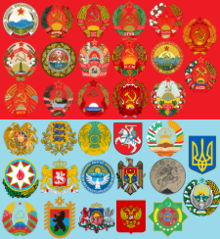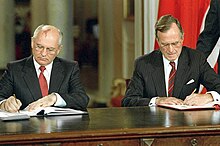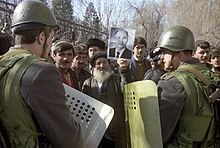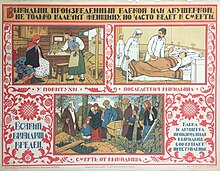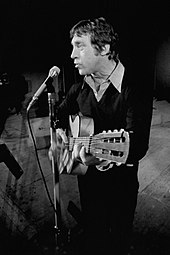From Wikipedia, the free encyclopedia
Union of Soviet Socialist Republics
Союз Советских
Социалистических Республик (Russian)
Soyuz Sovetskikh Sotsialisticheskikh Respublik
|
|---|
| 1922–1991 |
|
|
Motto: " Workers of the world, unite!"
Пролетарии всех стран, соединяйтесь!
(Proletarii vsekh stran, soyedinyaytes'!
Literally: "Proletarians of all countries, unite!")
|
|
 |
Capital
and largest city | Moscow
 55°45′N 37°37′E 55°45′N 37°37′E |
|---|
| Official languages | Russian |
|---|
| Recognised regional languages |
|
|---|
| Minority languages |
|
|---|
| Ethnic groups (1989) | 70% East Slavs
12% Turkic
18% other ethnic groups |
|---|
| Religion | State atheism |
|---|
| Demonym | Soviet, Russian |
|---|
| Government | 1922–27; 1953–90:
Federal Marxist–Leninist one-party socialist republic
1927–53:
Stalinist one-party totalitarian dictatorship
1990–91:
Federal semi-presidential republic |
|---|
| General Secretary | |
|---|
|
• 1922–1952
| Joseph Stalin (first) |
|---|
• 1991
| Vladimir Ivashko (last) |
|---|
| Head of state | |
|---|
|
• 1922–1938
| Mikhail Kalinin (first) |
|---|
• 1988–1991
| Mikhail Gorbachev (last) |
|---|
| Head of government | |
|---|
|
• 1922–1924
| Vladimir Lenin (first) |
|---|
• 1991
| Ivan Silayev (last) |
|---|
| Legislature | Supreme Soviet |
|---|
|
| Soviet of Nationalities |
|---|
|
| Soviet of the Union |
|---|
| Historical era | 20th century |
|---|
|
|
| 30 December 1922 |
|---|
|
| 1941–45 |
|---|
|
| 24 October 1945 |
|---|
|
| 9 October 1977 |
|---|
|
| 26 December 1991 |
|---|
| Area |
|---|
• Total
| 22,402,200 km2 (8,649,500 sq mi) |
|---|
| Population |
|---|
• 1991 estimate
| 293,047,571 |
|---|
• Density
| 8.4/km2 (21.8/sq mi) |
|---|
| GDP (PPP) | 1990 estimate |
|---|
• Total
| 2,659 billion |
|---|
| GDP (nominal) | 1989 estimate |
|---|
• Total
| $2.6595 trillion |
|---|
| Currency | Soviet ruble (руб) (SUR) |
|---|
| Time zone | (UTC+2 to +12) |
|---|
| Date format | dd-mm-yyyy |
|---|
| Drives on the | right |
|---|
| Calling code | +7 |
|---|
| ISO 3166 code | SU |
|---|
| Internet TLD | .su |
|---|
|
|
|
The
Soviet Union, officially the
Union of Soviet Socialist Republics (
USSR), was a
socialist federation in
Eurasia that existed from 1922 to 1991. Nominally a
union of multiple national
Soviet republics, its
government and
economy were highly
centralized. The country was a
one-party state, governed by the
Communist Party with
Moscow as its capital in its largest republic, the
Russian Soviet Federative Socialist Republic (Russian SFSR). The
Russian nation had
constitutionally equal status among the many
nations of the union, but exerted
de facto dominance in various respects. Other major urban centres were
Leningrad,
Kiev,
Minsk,
Alma-Ata and
Novosibirsk.
Extending across the entirety of
Northern Asia and much of
Eastern Europe, the Soviet Union had spanned
eleven time zones and incorporated a wide range of
environments and landforms. From northwest to southeast, the Soviet Union
shared land borders with
Norway,
Finland,
Poland,
Czechoslovakia,
Hungary,
Romania,
Turkey,
Iran,
Afghanistan,
China,
Mongolia and
North Korea. It shared its
maritime borders with
Japan by the
Sea of Okhotsk and the
U.S. state of
Alaska across the
Bering Strait. With an area of 22,402,200 square kilometres (8,649,500 sq mi), the Soviet Union was the
largest country in the world by area, covering more than one-eighth of the Earth's inhabited land area, and the
third most populous, with over 288 million people as of 1989, with the 80% of the population live in the
western, European part of the country.
The Soviet Union had its roots in the
October Revolution of 1917, when the
Bolsheviks led by
Vladimir Lenin overthrew the
Russian Provisional Government which had replaced
Tsar Nicholas II during
World War I. In 1922, the Soviet Union was formed by the
Treaty on the Creation of the USSR which legalized the unification of the
Russian,
Transcaucasian,
Ukrainian and
Byelorussian republics that had occurred from 1918. Following Lenin's death in 1924 and a brief power struggle,
Joseph Stalin came to power in the mid-1920s. Stalin committed the state's ideology to
Marxism–Leninism (which he created) and constructed a
command economy which led to a period of
rapid industrialization and
collectivization. During this period of
totalitarian rule, political paranoia fermented and the late-1930s
Great Purge
removed Stalin's opponents within and outside of the party via
arbitrary arrests and persecutions of many people, resulting in over
600,000 deaths.
Suppression of political critics,
forced labor were carried out by Stalin's government. In 1933, a major famine that became known as the
Holodomor in
Soviet Ukraine struck multiple Soviet grain-growing regions, causing the deaths of some 3 to 7 million people.
In August 1939, days before the start of
World War II, the USSR signed the
Molotov–Ribbentrop Pact agreeing to non-aggression with
Nazi Germany, after which the two countries
invaded Poland in September 1939. In June 1941,
the pact collapsed as Germany turned to attack the Soviet Union, opening
the largest and bloodiest theatre of war in history.
Soviet war casualties accounted for the highest proportion of the conflict in the effort of acquiring the upper hand over
Axis forces at intense battles such as
Stalingrad and
Kursk. The territories overtaken by the Red Army became
satellite states
of the Soviet Union and the postwar division of Europe into capitalist
and communist halves would lead to increased tensions with
the West, led by the
United States of America.
The
Cold War emerged by 1947 as the
Eastern Bloc, united under the
Warsaw Pact in 1955, confronted the Western Bloc, united under
NATO in 1949. On 5 March 1953, Stalin
died and was eventually succeeded by
Nikita Khrushchev, who in 1956
denounced Stalin and began the
de-Stalinization of
Soviet society through the
Khrushchev Thaw. The Soviet Union took an early lead in the
Space Race, with the
first artificial satellite and the
first human spaceflight. Dissatisfied with Khrushchev's policies, the Communist Party's conservative wing led a
coup d'état against Khrushchev in 1964, quietly ousting him without any bloodshed. In the early 1970s, there was a brief
détente of relations with the United States, but tensions resumed with the
Soviet–Afghan War in 1979. In the mid-1980s, the last Soviet leader,
Mikhail Gorbachev, sought to reform and liberalize the economy through his policies of
glasnost (openness) and
perestroika (restructuring). Under Gorbachev, the role of the Communist Party in governing the state was removed from
the constitution, causing a surge of severe political instability to set in. The Cold War ended during his tenure in 1989 as
Soviet satellite states in
Eastern Europe and
overthrew their respective communist governments.
With the rise of strong
nationalist and separatist movements inside the
union republics, Gorbachev tried to avert a
dissolution of the Soviet Union in the post-Cold War era. A
March 1991 referendum, boycotted by some republics, resulted in a majority of participating citizens voting in favor of preserving the union as a
renewed federation. Gorbachev's power was greatly diminished after Russian President
Boris Yeltsin played a high-profile role in facing down an
abortive August 1991 coup d'état
attempted by Communist Party hardliners. On 25 December 1991, Gorbachev
resigned and the remaining twelve constituent republics emerged as
independent
post-Soviet states. The
Russian Federation—formerly the Russian SFSR—assumed the Soviet Union's rights and obligations and is recognized as the
successor state of the Soviet Union. In summing up the international ramifications of these events,
Vladislav Zubok
stated: "The collapse of the Soviet empire was an event of epochal
geopolitical, military, ideological and economic significance".
Throughout its existence, the Soviet Union was a powerhouse of the
most significant technological achievements and innovations of the 20th century, including the world's
first human-made satellite and the launching of the
first humans in space. The country had the world's second largest economy and the largest standing military in the world. The Soviet Union was
recognized as one of the five
nuclear weapons states and possessed the
largest stockpile of weapons of mass destruction. It was a founding
permanent member of the
United Nations Security Council as well as a member of the
Organization for Security and Co-operation in Europe (OSCE), the
World Federation of Trade Unions (WFTU) and the leading member of the
Council for Mutual Economic Assistance (CMEA) and the
Warsaw Pact.
Name
The word "
Soviet" is derived from a
Russian word meaning council, assembly, advice, harmony, concord and all ultimately deriving from the proto-Slavic verbal stem of
vět-iti ("to inform"), related to Slavic
věst ("news"), English "wise", the root in "ad-vis-or" (which came to English through French), or the Dutch
weten ("to know"; cf.
wetenschap meaning "science"). The word
sovietnik means "councillor".
A number of organizations in Russian history were called "council" (
Russian:
сове́т). For example, in the
Russian Empire the
State Council, which functioned from 1810 to 1917, was referred to as a Council of Ministers after the revolt of 1905.
During the
Georgian Affair,
Vladimir Lenin envisioned an expression of
Great Russian ethnic chauvinism by
Joseph Stalin
and his supporters, calling for these nation-states to join Russia as
semi-independent parts of a greater union, which he initially named as
the Union of Soviet Republics of Europe and Asia (
Russian:
Сою́з Сове́тских Респу́блик Евро́пы и А́зии,
tr. Soyúz Sovétskikh Respúblik Evrópy i Ázii).
Stalin initially resisted the proposal, but ultimately accepted it,
although with Lenin's agreement changed the name of the newly proposed
state to the Union of Soviet Socialist Republics, albeit all the
republics began as "Socialist Soviet" and did not change to the other
order until
1936.
In addition, in the national languages of several republics the word
"Council/Conciliar" in the respective language was only quite late
changed to an adaptation of the Russian "Soviet" and never in others,
e.g.
Ukraine.
In some cases, due to the length of its name the state was
referred to as the Soviet Union or the USSR, especially when used in the
Western media. It was also informally called Russia (and its citizens Russians), though that was technically incorrect since Russia was only one of the republics.
Geography, climate and environment
With an area of 22,402,200 square kilometres (8,649,500 sq mi), the Soviet Union was the
world's largest country, a status that is retained by the
Russian Federation. Covering a sixth of
Earth's land surface, its size was comparable to that of
North America. The
European portion accounted for a quarter of the country's area, and was the cultural and economic center. The eastern part in
Asia extended to the
Pacific Ocean to the east and
Afghanistan to the south, and, except some areas in
Central Asia, was much less populous. It spanned over 10,000 kilometres (6,200 mi) east to west across 11
time zones, and over 7,200 kilometres (4,500 mi) north to south. It had five climate zones:
tundra,
taiga,
steppes,
desert and
mountains.
The Soviet Union had the world's longest
border, like
Russia, measuring over 60,000 kilometres (37,000 mi), or
1 1⁄2 circumferences of
Earth. Two-thirds of it was a
coastline. Across the
Bering Strait was the
United States. The Soviet Union bordered
Afghanistan,
China,
Czechoslovakia,
Finland,
Hungary,
Iran,
Mongolia,
North Korea,
Norway,
Poland,
Romania, and
Turkey from 1945 to 1991.
The Soviet Union's highest mountain was Communism Peak (now
Ismoil Somoni Peak) in
Tajikistan, at 7,495 metres (24,590 ft). The Soviet Union also included most of the world's largest lakes; the
Caspian Sea (shared with
Iran), and
Lake Baikal, the world's largest and deepest freshwater lake that is also an internal body of water in Russia.
History
The last Russian
Tsar,
Nicholas II, ruled the
Russian Empire until his abdication in March 1917 in the aftermath of the
February Revolution, due in part to the strain of fighting in
World War I, which lacked public support. A short-lived
Russian Provisional Government took power, to be overthrown in the
October Revolution (
N.S. 7 November 1917) by revolutionaries led by the
Bolshevik leader
Vladimir Lenin.
A spontaneous popular uprising in
Petrograd, in response to the wartime decay of Russia's economy and morale, culminated in the
February Revolution and the toppling of the imperial government in March 1917. The
tsarist autocracy was replaced by the Russian Provisional Government, which intended to conduct elections to the
Russian Constituent Assembly and to continue fighting on the side of the
Entente in World War I.
At the same time,
workers' councils, known in
Russian as "
Soviets", sprang up across the country. The
Bolsheviks, led by
Vladimir Lenin, pushed for
socialist revolution in the Soviets and on the streets. On 7 November 1917, the Red Guards stormed the
Winter Palace
in Petrograd, ending the rule of the Provisional Government and leaving
all political power to the Soviets. This event would later be
officially known in Soviet bibliographies as the
Great October Socialist Revolution. In December, the Bolsheviks signed an
armistice with the
Central Powers, though by February 1918, fighting had resumed. In March, the Soviets ended involvement in the war for good and signed the
Treaty of Brest-Litovsk.
A long and bloody
Civil War ensued between the
Reds and the
Whites, starting in 1917 and ending in 1923 with the Reds' victory. It included
foreign intervention, the
execution of the former tsar and his family, and the
famine of 1921, which killed about five million people. In March 1921, during
a related conflict with Poland, the
Peace of Riga was signed, splitting disputed territories in
Belarus and
Ukraine between the
Republic of Poland and Soviet Russia. Soviet Russia had to resolve similar conflicts with the newly established
Republic of Finland, the
Republic of Estonia, the
Republic of Latvia, and the
Republic of Lithuania.
Unification of republics
On 28 December 1922, a conference of plenipotentiary delegations from the
Russian SFSR, the
Transcaucasian SFSR, the
Ukrainian SSR and the
Byelorussian SSR approved the
Treaty on the Creation of the USSR and the
Declaration of the Creation of the USSR, forming the Union of Soviet Socialist Republics. These two documents were confirmed by the 1st
Congress of Soviets of the USSR and signed by the heads of the delegations,
Mikhail Kalinin,
Mikhail Tskhakaya,
Mikhail Frunze,
Grigory Petrovsky, and
Alexander Chervyakov, on 30 December 1922. The formal proclamation was made from the stage of the
Bolshoi Theatre.
On 1 February 1924, the USSR was recognized by the United Kingdom. The same year, a
Soviet Constitution was approved, legitimizing the December 1922 union.
An intensive restructuring of the economy, industry and politics
of the country began in the early days of Soviet power in 1917. A large
part of this was done according to the
Bolshevik Initial Decrees, government documents signed by Vladimir Lenin. One of the most prominent breakthroughs was the
GOELRO plan, which envisioned a major restructuring of the Soviet economy based on total electrification of the country.
The plan was developed in 1920 and covered a 10 to 15-year period. It included construction of a network of 30 regional
power stations, including ten large
hydroelectric power plants, and numerous electric-powered large industrial enterprises.
The plan became the prototype for subsequent
Five-Year Plans and was fulfilled by 1931.
Stalin era
USSR in 1922 and 1936 (Russian SFSR in red).
From its creation, the government in the Soviet Union was based on the
one-party rule of the
Communist Party (Bolsheviks). After the economic policy of "
War communism" during the Russian Civil War, as a prelude to fully developing
socialism in the country, the Soviet government
permitted some private enterprise to coexist alongside nationalized industry in the 1920s and total food requisition in the countryside was replaced by a food tax.
The stated purpose of the one-party state was to ensure that
capitalist exploitation would not return to the Soviet Union and that
the principles of
democratic centralism
would be most effective in representing the people's will in a
practical manner. Debate over the future of the economy provided the
background for a power struggle in the years after Lenin's death in
1924. Initially, Lenin was to be replaced by a "
troika" consisting of
Grigory Zinoviev of the
Ukrainian SSR,
Lev Kamenev of the
Russian SFSR, and
Joseph Stalin of the
Transcaucasian SFSR.
On 3 April 1922, Stalin was named the
General Secretary of the Communist Party of the Soviet Union. Lenin had appointed Stalin the head of the
Workers' and Peasants' Inspectorate, which gave Stalin considerable power. By
gradually consolidating his influence and isolating and outmaneuvering his rivals within the party, Stalin became the
undisputed leader of the Soviet Union and, by the end of the 1920s, established
totalitarian rule. In October 1927, Grigory Zinoviev and
Leon Trotsky were expelled from the
Central Committee and forced into exile.
In 1928, Stalin introduced the
first five-year plan for building a
socialist economy. In place of the
internationalism expressed by Lenin throughout the Revolution, it aimed to build
Socialism in One Country.
In industry, the state assumed control over all existing enterprises
and undertook an intensive program of industrialization. In agriculture,
rather than adhering to the "lead by example" policy advocated by
Lenin, forced
collectivization of farms was implemented all over the country.
Famines ensued, causing millions of deaths; surviving
kulaks were persecuted and many sent to
Gulags to do
forced labour. Social upheaval continued in the mid-1930s. Stalin's
Great Purge resulted in the execution or detainment of many "
Old Bolsheviks" who had participated in the October Revolution with Lenin. According to declassified Soviet archives, the
NKVD arrested more than one and a half million people in 1937 and 1938, of whom 681,692 were shot. Over those two years there were an average of over one thousand executions a day. According to historian
Geoffrey Hosking, "...excess deaths during the 1930s as a whole were in the range of 10–11 million", although historian
Timothy D. Snyder claims that archival evidence suggests a maximum excess mortality of nine million during the entire Stalin era. Historian and archival researcher
Stephen G. Wheatcroft
asserts that around a million "purposive killings" can be attributed to
Stalinist regime, along with the premature deaths of roughly two
million more amongst the repressed populations (i.e., in camps, prisons,
exile, etc.) through criminal negligence. Despite the turmoil of the mid-to-late 1930s, the Soviet Union developed a powerful industrial economy in the years before
World War II.
Under the doctrine of
state atheism in the Soviet Union, there was a "government-sponsored program of forced conversion to
atheism" conducted by Communists. The
communist regime
targeted religions based on State interests, and while most organized
religions were never outlawed, religious property was confiscated,
believers were harassed, and religion was ridiculed while atheism was
propagated in schools. In 1925 the government founded the
League of Militant Atheists to intensify the propaganda campaign.
Accordingly, although personal expressions of religious faith were not
explicitly banned, a strong sense of social stigma was imposed on them
by the official structures and mass media and it was generally
considered unacceptable for members of certain professions (teachers,
state bureaucrats, soldiers) to be openly religious. As for the Russian
Orthodox Church, Soviet authorities sought to control it and, in times
of national crisis, to exploit it for the regime's own purposes; but
their ultimate goal was to eliminate it. During the first five years of
Soviet power, the Bolsheviks executed 28 Russian Orthodox bishops and
over 1,200 Russian Orthodox priests. Many others were imprisoned or
exiled. Believers were harassed and persecuted. Most seminaries were
closed, and the publication of most religious material was prohibited.
By 1941 only 500 churches remained open out of about 54,000 in existence
prior to World War I.
1930s
Closer cooperation between the Soviet Union and the West developed in
the early 1930s. From 1932 to 1934, the Soviet Union participated in
the
World Disarmament Conference.
In 1933, diplomatic relations between the United States and the USSR
were established when in November the newly elected President of the
United States, Franklin D. Roosevelt, chose to formally recognize
Stalin's Communist government and negotiated a new trade agreement
between the two nations. In September 1934, the Soviet Union joined the
League of Nations. After the
Spanish Civil War broke out in 1936, the USSR actively supported the
Republican forces against the
Nationalists, who were supported by
Fascist Italy and
Nazi Germany.
"Strengthen working discipline in collective farms", a Soviet propaganda poster issued in
Uzbekistan, 1933
In December 1936, Stalin unveiled a new
Soviet Constitution. Supporters around the world hailed it as the most democratic Constitution imaginable. Historian
J. Arch Getty concludes:
Many who lauded Stalin's Soviet
Union as the most democratic country on earth lived to regret their
words. After all, the Soviet Constitution of 1936 was adopted on the eve
of the Great Terror of the late 1930s; the "thoroughly democratic"
elections to the first Supreme Soviet permitted only uncontested
candidates and took place at the height of the savage violence in 1937.
The civil rights, personal freedoms, and democratic forms promised in
the Stalin constitution were trampled almost immediately and remained
dead letters until long after Stalin's death.
In 1939, the Soviet Union made a dramatic shift toward Nazi Germany. Almost a year after Britain and France had concluded the
Munich Agreement with Germany, the Soviet Union made agreements with Germany as well, both militarily and economically during
extensive talks. The two countries concluded the
Molotov–Ribbentrop Pact and the
German–Soviet Commercial Agreement in August 1939. The nonaggression pact made possible Soviet occupation of
Lithuania, Latvia, Estonia,
Bessarabia, northern Bukovina, and
eastern Poland. In late November, unable to coerce the
Republic of Finland by diplomatic means into moving its border 25 kilometres (16 mi) back from
Leningrad, Joseph Stalin ordered the
invasion of Finland.
In the east, the Soviet military won several decisive victories during
border clashes with the
Empire of Japan in 1938 and 1939. However, in April 1941, USSR signed the
Soviet–Japanese Neutrality Pact with the Japan, recognizing the territorial integrity of
Manchukuo, a Japanese
puppet state.
World War II
The
Battle of Stalingrad is considered by many historians as a decisive turning point of World War II.
Although it has been
debated whether the Soviet Union intended to invade Germany once it was strong enough, Germany itself broke the treaty and
invaded the Soviet Union on 22 June 1941, starting what was known in the USSR as the "
Great Patriotic War". The
Red Army stopped the seemingly invincible German Army at the
Battle of Moscow, aided by an unusually harsh winter. The
Battle of Stalingrad,
which lasted from late 1942 to early 1943, dealt a severe blow to the
Germans from which they never fully recovered and became a turning point
in the war. After Stalingrad, Soviet forces drove through Eastern
Europe to Berlin before
Germany surrendered in 1945. The German Army suffered 80% of its military deaths in the Eastern Front.
The same year, the USSR, in fulfillment of its agreement with the Allies at the
Yalta Conference, denounced the Soviet–Japanese Neutrality Pact in April 1945 and
invaded Manchukuo and other Japan-controlled territories on 9 August 1945.
This conflict ended with a decisive Soviet victory, contributing to the unconditional
surrender of Japan and the end of World War II.
The Soviet Union suffered greatly in the war,
losing around 27 million people. Approximately 2.8 million
Soviet POWs died of starvation, mistreatment, or executions in just eight months of 1941–42. During the war, the Soviet Union together with the United States, the United Kingdom and China were considered the
Big Four Allied powers in World War II, and later became the
Four Policemen, which formed the basis of the
United Nations Security Council. It emerged as a superpower in the post-war period. Once denied
diplomatic recognition
by the Western world, the Soviet Union had official relations with
practically every nation by the late 1940s. A member of the United
Nations at its foundation in 1945, the Soviet Union
became one of the
five permanent members of the
United Nations Security Council, which gave it the right to veto any of its resolutions.
Memorandum for the President's Special Assistant
Harry Hopkins, Washington, D.C., August 10, 1943:
In War II Russia occupies a
dominant position and is the decisive factor looking toward the defeat
of the Axis in Europe. While in Sicily the forces of Great Britain and
the United States are being opposed by 2 German divisions, the Russian
front is receiving attention of approximately 200 German divisions.
Whenever the Allies open a second front on the Continent, it will be
decidedly a secondary front to that of Russia; theirs will continue to
be the main effort. Without Russia in the war, the Axis cannot be
defeated in Europe, and the position of the United Nations becomes
precarious. Similarly, Russia’s post-war position in Europe will be a
dominant one. With Germany crushed, there is no power in Europe to
oppose her tremendous military forces.
The Soviet Union maintained its status as one of the world's two
superpowers for four decades through its hegemony in Eastern Europe,
military strength, economic strength, aid to
developing countries, and scientific research, especially in space technology and weaponry.
Cold War
During the immediate postwar period, the Soviet Union rebuilt and expanded its economy, while maintaining its
strictly centralized control. It took effective control over most of the countries of Eastern Europe (except Yugoslavia and Albania), turning them into
satellite states. The Soviet Union bound its satellite states in a military alliance, the
Warsaw Pact, in 1955, and an economic organization,
The Council for Mutual Economic Assistance or Comecon, a counterpart to the
European Economic Community, from 1949 to 1991.
The Soviet Union concentrated on its own recovery, seizing and
transferring most of Germany's industrial plants, and it exacted war
reparations from East Germany, Hungary, Romania, and Bulgaria using
Soviet-dominated joint enterprises. It also instituted trading
arrangements deliberately designed to favor the Soviet Union. Moscow
controlled the Communist parties that ruled the satellite states, and
they followed orders from the Kremlin. Historian Mark Kramer concludes:
The net outflow of resources from
eastern Europe to the Soviet Union was approximately $15 billion to $20
billion in the first decade after World War II, an amount roughly equal
to the total aid provided by the United States to western Europe under
the Marshall Plan.
Later, the Comecon supplied aid to the eventually victorious
Communist Party of China,
and its influence grew elsewhere in the world. Fearing its ambitions,
the Soviet Union's wartime allies, the United Kingdom and the United
States, became its enemies. In the ensuing
Cold War, the two sides clashed indirectly in
proxy wars.
Khrushchev era
Stalin died on 5 March 1953. Without a mutually agreeable successor,
the highest Communist Party officials initially opted to rule the Soviet
Union jointly through a troika headed by
Georgy Malenkov. This did not last, however, and
Nikita Khrushchev eventually won the power struggle by the mid-1950s. He shortly afterward
denounced Stalin's use of repression in 1956 and proceeded to ease Stalin's repressive controls over party and society. This was known as
de-Stalinization.
Globe
showing the greatest territorial extent of the Soviet Union and states
that were dominated politically, economically and/or militarily by it
(which was in 1960), namely the period of time just after the
Cuban Revolution of 1959 and just before the official
Sino-Soviet split of 1961.
Moscow considered Eastern Europe to be a critically vital buffer zone
for the forward defense of its western borders, in case of another
major invasion such as the German invasion of 1940. For this reason, the
USSR sought to cement its control of the region by transforming the
Eastern European countries into satellite states, dependent upon, and
subservient to, its leadership. Soviet military force was used to
suppress anti-Stalinist uprisings in
Hungary and
Poland in 1956.
In the late 1950s, a confrontation with China regarding the USSR's rapprochement with the West, and what
Mao Zedong perceived as Khrushchev's
revisionism, led to the
Sino–Soviet split. This resulted in a break throughout the global Marxist–Leninist movement, with the governments in
Albania,
Cambodia and
Somalia choosing to ally with China in place of the USSR.
During this period of the late 1950s and early 1960s, the Soviet
Union continued to realize scientific and technological exploits in the
Space Race, rivaling the United States: launching the first artificial satellite,
Sputnik 1 in 1957; a living dog named
Laika in 1957; the first human being,
Yuri Gagarin in 1961; the first woman in space,
Valentina Tereshkova in 1963;
Alexey Leonov,
the first person to walk in space in 1965; the first soft landing on
the moon by spacecraft Luna 9 in 1966; and the first moon rovers,
Lunokhod 1 and
Lunokhod 2.
Soviet cosmonaut
Yuri Gagarin, first human to travel into space
Khrushchev initiated "
The Thaw",
a complex shift in political, cultural and economic life in the Soviet
Union. This included some openness and contact with other nations and
new social and economic policies with more emphasis on commodity goods,
allowing living standards to rise dramatically while maintaining high
levels of economic growth. Censorship was relaxed as well.
Khrushchev's reforms in agriculture and administration, however, were generally unproductive. In 1962, he precipitated a
crisis with the United States over the Soviet deployment of
nuclear missiles in
Cuba. An agreement was made between the Soviet Union and the United States to remove enemy nuclear missiles from both Cuba and
Turkey,
concluding the crisis. This event caused Khrushchev much embarrassment
and loss of prestige, resulting in his removal from power in 1964.
Era of Stagnation
The Era of Stagnation was a period of negative economic, political,
and social effects in the Soviet Union, which began during the rule of
Leonid Brezhnev and continued under
Yuri Andropov and
Konstantin Chernenko.
Following the ousting of Khrushchev, another period of
collective leadership ensued, consisting of Leonid Brezhnev as General Secretary,
Alexei Kosygin as Premier and
Nikolai Podgorny as Chairman of the Presidium, lasting until Brezhnev established himself in the early 1970s as the preeminent Soviet leader.
In 1968, the Soviet Union and Warsaw Pact allies
invaded Czechoslovakia to halt the
Prague Spring
reforms. In the aftermath, Brezhnev justified the invasion along with
the earlier invasions of Eastern European states by introducing the
Brezhnev Doctrine,
which claimed the right of the Soviet Union to violate the sovereignty
of any country that attempted to replace Marxism–Leninism with
capitalism.
Brezhnev presided over a period of
détente with the West that resulted in treaties on armament control (
SALT I,
SALT II,
Anti-Ballistic Missile Treaty) while at the same time building up Soviet military might.
In October 1977, the
third Soviet Constitution
was unanimously adopted. The prevailing mood of the Soviet leadership
at the time of Brezhnev's death in 1982 was one of aversion to change.
The long period of Brezhnev's rule had come to be dubbed one of
"standstill", with an aging and ossified top political leadership.
Gorbachev era
Two developments dominated the decade that followed: the increasingly
apparent crumbling of the Soviet Union's economic and political
structures, and the patchwork attempts at reforms to reverse that
process. Kenneth S. Deffeyes argued in
Beyond Oil that the
Reagan administration encouraged
Saudi Arabia to
lower the price of oil to the point where the Soviets could not make a profit selling their oil, so the USSR's
hard currency reserves became depleted.
Brezhnev's next two successors, transitional figures with deep roots in his tradition, did not last long.
Yuri Andropov was 68 years old and
Konstantin Chernenko
72 when they assumed power; both died in less than two years. In an
attempt to avoid a third short-lived leader, in 1985, the Soviets turned
to the next generation and selected
Mikhail Gorbachev.
Gorbachev made significant changes in the economy and party leadership, called
perestroika. His policy of
glasnost freed public access to information after decades of heavy government censorship.
Gorbachev also moved to end the Cold War. In 1988, the Soviet Union abandoned its
nine-year war in Afghanistan and began to withdraw its forces. In the late 1980s,
he refused military support to the governments of the Soviet Union's satellite states, which paved the way for
Revolutions of 1989. With the tearing down of the
Berlin Wall and with
East Germany and
West Germany pursuing unification, the
Iron Curtain between
the West and Soviet-controlled regions came down.
In the late 1980s, the constituent republics of the Soviet Union started legal moves towards potentially declaring
sovereignty
over their territories, citing Article 72 of the USSR constitution,
which stated that any constituent republic was free to secede.
On 7 April 1990, a law was passed allowing a republic to secede if more
than two-thirds of its residents voted for it in a referendum. Many held their first free elections in the Soviet era for their own
national legislatures in 1990. Many of these legislatures proceeded to
produce legislation contradicting the Union laws in what was known as
the "
War of Laws".
In 1989, the
Russian SFSR,
which was then the largest constituent republic (with about half of the
population) convened a newly elected Congress of People's Deputies.
Boris Yeltsin was elected its chairman. On 12 June 1990, the Congress
declared Russia's sovereignty over its territory and proceeded to pass laws that attempted to supersede some of the USSR's laws. After a landslide victory of
Sąjūdis in Lithuania, that country declared its independence restored on 11 March 1990.
A
referendum for the preservation of the USSR
was held on 17 March 1991 in nine republics (the remainder having
boycotted the vote), with the majority of the population in those nine
republics voting for preservation of the Union. The referendum gave
Gorbachev a minor boost. In the summer of 1991, the
New Union Treaty, which would have turned the Soviet Union into a much looser Union, was agreed upon by eight republics.
The signing of the treaty, however, was interrupted by the
August Coup—an attempted
coup d'état
by hardline members of the government and the KGB who sought to reverse
Gorbachev's reforms and reassert the central government's control over
the republics. After the coup collapsed, Yeltsin was seen as a hero for
his decisive actions, while Gorbachev's power was effectively ended. The
balance of power tipped significantly towards the republics. In August
1991, Latvia and Estonia immediately declared the restoration of their
full independence (following Lithuania's 1990 example). Gorbachev
resigned as general secretary in late August, and soon afterward the
Party's activities were indefinitely suspended—effectively ending its
rule. By the fall, Gorbachev could no longer influence events outside
Moscow, and he was being challenged even there by Yeltsin, who had been
elected
President of Russia in July 1991.
Dissolution
The remaining 12 republics continued discussing new, increasingly
looser, models of the Union. However, by December all except Russia and
Kazakhstan had formally declared independence. During this time, Yeltsin took over what remained of the Soviet government, including the
Moscow Kremlin. The final blow was struck on 1 December when Ukraine, the second most powerful republic,
voted overwhelmingly for independence. Ukraine's secession ended any realistic chance of the Soviet Union staying together even on a limited scale.
Changes in national boundaries after the end of the
Cold War
On 8 December 1991, the presidents of Russia, Ukraine and
Belarus (formerly Byelorussia), signed the
Belavezha Accords, which declared the Soviet Union dissolved and established the
Commonwealth of Independent States
(CIS) in its place. While doubts remained over the authority of the
accords to do this, on 21 December 1991, the representatives of all
Soviet republics except
Georgia signed the
Alma-Ata Protocol,
which confirmed the accords. On 25 December 1991, Gorbachev resigned as
the President of the USSR, declaring the office extinct. He turned the
powers that had been vested in the presidency over to Yeltsin. That
night, the Soviet flag was lowered for the last time, and the
Russian tricolor was raised in its place.
The following day, the
Supreme Soviet,
the highest governmental body of the Soviet Union, voted both itself
and the Soviet Union out of existence. This is generally recognized as
marking the official, final
dissolution of the Soviet Union as a functioning state.
The Soviet Army originally remained under overall CIS command, but was
soon absorbed into the different military forces of the newly
independent states. The few remaining Soviet institutions that had not
been taken over by Russia ceased to function by the end of 1991.
Following the dissolution of the Soviet Union on 26 December 1991, Russia was internationally recognized as its
legal successor
on the international stage. To that end, Russia voluntarily accepted
all Soviet foreign debt and claimed overseas Soviet properties as its
own. Under the 1992
Lisbon Protocol,
Russia also agreed to receive all nuclear weapons remaining in the
territory of other former Soviet republics. Since then, the Russian
Federation has assumed the Soviet Union's rights and obligations.
Ukraine
has refused to recognize exclusive Russian claims to succession of the
USSR and claimed such status for Ukraine as well, which was codified in
Articles 7 and 8 of its 1991 law
On Legal Succession of Ukraine.
Since its independence in 1991, Ukraine has continued to pursue claims
against Russia in foreign courts, seeking to recover its share of the
foreign property that was owned by the USSR.
Internally displaced
Azerbaijanis from Nagorno-Karabakh, 1993
Country emblems of the Soviet Republics before and after the dissolution of the Soviet Union (note that the
Transcaucasian Soviet Federative Socialist Republic (fifth in the second row) no longer exists as a political entity of any kind and the emblem is unofficial).
The
dissolution of the Soviet Union was followed by a severe economic contraction and catastrophic fall in
living standards in
post-Soviet states including a rapid increase in poverty, crime,corruption, unemployment, homelessness, rates of disease, demographic losses, income inequality and the rise of an
oligarchical class, along with decreases in calorie intake, life expectancy, adult literacy, and income. Between 1988/1989 and 1993/1995, the
Gini ratio increased by an average of 9 points for all former socialist countries. The economic shocks that accompanied wholesale
privatization
were associated with sharp increases in mortality. Data shows Russia,
Kazakhstan, Latvia, Lithuania and Estonia saw a tripling of unemployment
and a 42% increase in male death rates between 1991 and 1994.
In the following decades, only five or six of the post-communist states
are on a path to joining the wealthy capitalist West while most are
falling behind, some to such an extent that it will take over fifty
years to catch up to where they were before the fall of the Soviet Bloc.
In summing up the international ramifications of these events,
Vladislav Zubok
stated: "The collapse of the Soviet empire was an event of epochal
geopolitical, military, ideological, and economic significance
Post-Soviet states
The analysis of the
succession of states with respect to the 15
post-Soviet states is complex. The
Russian Federation is seen as the legal
continuator
state and is for most purposes the heir to the Soviet Union. It
retained ownership of all former Soviet embassy properties, as well as
the old Soviet UN membership and permanent membership on the
Security Council.
There are additionally four states that claim independence from the other internationally recognized post-Soviet states, but
possess limited international recognition:
Abkhazia,
Nagorno-Karabakh,
South Ossetia, and
Transnistria. The
Chechen separatist movement of the
Chechen Republic of Ichkeria lacks any international recognition.
Organizations
1960s Cuba-Soviet friendship poster with
Fidel Castro and Nikita Khrushchev
Stalin always made the final policy decisions, 1925–1953. Otherwise
Soviet foreign policy was set by the Commission on the Foreign Policy of
the Central Committee of the
Communist Party of the Soviet Union, or by the Party's highest body the
Politburo. Operations were handled by the separate
Ministry of Foreign Affairs.
It was known as the People's Commissariat for Foreign Affairs (or
Narkomindel), until 1946. The most influential spokesmen were
Georgy Chicherin (1872–1936),
Maxim Litvinov (1876–1951),
Vyacheslav Molotov (1890–1986),
Andrey Vyshinsky (1883–1954) and
Andrei Gromyko (1909–1989). Intellectuals were based in the
Moscow State Institute of International Relations.
- Comintern (1919–1943), or Communist International, was an international communist organization based in the Kremlin that advocated world communism.
The Comintern intended to "struggle by all available means, including
armed force, for the overthrow of the international bourgeoisie and the
creation of an international Soviet republic as a transition stage to
the complete abolition of the state". It was abolished as a conciliatory measure toward Britain and the United States.
- Comecon, the Council for Mutual Economic Assistance (Russian: Совет Экономической Взаимопомощи, Sovet Ekonomicheskoy Vzaimopomoshchi,
СЭВ, SEV) was an economic organization from 1949 to 1991 under Soviet
control that comprised the countries of the Eastern Bloc along with a
number of communist states elsewhere in the world. Moscow was concerned
about the Marshall Plan
and Comecon was meant to prevent countries in the Soviets' sphere of
influence from moving towards that of the Americans and South-East Asia.
Comecon was the Eastern Bloc's reply to the formation in Western Europe
of the Organization for European Economic Co-Operation (OEEC).
- The Warsaw Pact was a collective defence alliance formed in 1955 among the Soviet Union and seven Soviet satellite states of Central and Eastern Europe during the Cold War. The Warsaw Pact was the military complement to the Comecon, the regional economic organization for the socialist states of Central and Eastern Europe. The Warsaw Pact was created in reaction to the integration of West Germany into NATO.
- The Cominform
(1947–1956), informally the Communist Information Bureau and officially
the Information Bureau of the Communist and Workers' Parties, was the
first official agency of the international communist movement since the
dissolution of the Comintern in 1943. Its role was to coordinate actions
between communist parties under Soviet direction. Stalin used it to
order Western European communist parties to abandon their exclusively
parliamentarian line and instead concentrate on politically impeding the
operations of the Marshall Plan. It also coordinated international aid to communist insurgents during the Greek Civil War in 1947–1949. It expelled Yugoslavia in 1948 after Josip Broz Tito insisted on an independent program. Its newspaper, For a Lasting Peace, for a People's Democracy!,
promoted Stalin's positions. The Cominform's concentration on Europe
meant a deemphasis on world revolution in Soviet foreign policy. By
enunciating a uniform ideology, it allowed the constituent parties to
focus on personalities rather than issues.
Early Soviet foreign policies (1919–1939)
The Communist leadership the Soviet Union intensely debated foreign
policy issues and change directions several times. Even after Stalin
assumed dictatorial control in the late 1920s, there were debates and he
frequently changed positions.
The first stage (1917–1921), assumed that Communist revolutions
would break out very soon in every major industrial country, and it was
the Soviet responsibility to assist them. The
Comintern
was the weapon of choice. A few revolutions did break out, but they
were quickly suppressed (the longest lasting one was in Hungary)—the
Hungarian Soviet Republic—lasted only from 21 March 1919 to 1 August 1919. The Russian Bolsheviks were in no position to give any help.
By 1921, the second stage came with the realization by Lenin,
Trotsky, and Stalin that capitalism had stabilized itself in Europe and
there would not be any widespread revolutions anytime soon. It became
the duty of the Russian Bolsheviks to protect what they had in Russia,
and avoid military confrontations that might destroy their bridgehead.
Russia was now in it a pariah state, along with Germany. The two came
to terms in 1922 with the
Treaty of Rapallo
that settled long-standing grievances. At the same time the two
countries secretly set up training programs for illegal German army and
air force operations at hidden camps in the Soviet Union.
At the same time,
Moscow
stopped threatening other states, and instead worked to open peaceful
relationships in terms of trade, and diplomatic recognition.
United Kingdom, dismissed the warnings of
Winston Churchill
and a few others about a continuing communist threat, and opened trade
relations and de facto diplomatic recognition in 1922. There was hope
for a settlement of the prewar tsarist debts, but that issue was
repeatedly postponed. Formal recognition came when the new Labour Party
came to power in 1924. All the other major countries opened trade relationships.
Henry Ford
opened large-scale business relationships with the Soviets in the late
1920s, hoping it would lead to a long-term peace. Finally, in 1933, the
United States
officially recognized the Soviet Union, a decision backed by public
opinion and especially by American business interests that expected a
new profitable market would open up.
A third stage came in the late 1920s and early 1930s, when Stalin
ordered Communist parties across the world to strongly oppose
non-communist political parties, labor unions or other organizations on
the left. Stalin reversed himself in 1934 with the
Popular Front program the called on all Communist parties to join together with all
anti-Fascist political, labor, and organizational forces that were opposed to
fascism, especially of the
Nazi variety.
Politics
There were three power hierarchies in the Soviet Union: the
legislature represented by the
Supreme Soviet of the Soviet Union, the government represented by the
Council of Ministers, and the
Communist Party of the Soviet Union (CPSU), the only legal party and the ultimate policymaker in the country.
Communist Party
At the top of the Communist Party was the
Central Committee, elected at
Party Congresses and Conferences. The Central Committee in turn voted for a
Politburo (called the Presidium between 1952–1966),
Secretariat and the
General Secretary (First Secretary from 1953 to 1966), the de facto highest office in the Soviet Union.
Depending on the degree of power consolidation, it was either the
Politburo as a collective body or the General Secretary, who always was
one of the Politburo members, that effectively led the party and the
country
(except for the period of the highly personalized authority of Stalin,
exercised directly through his position in the Council of Ministers
rather than the Politburo after 1941). They were not controlled by the general party membership, as the key principle of the party organization was
democratic centralism, demanding strict subordination to higher bodies, and elections went uncontested, endorsing the candidates proposed from above.
The Communist Party maintained its dominance over the state largely through its control over the
system of appointments.
All senior government officials and most deputies of the Supreme Soviet
were members of the CPSU. Of the party heads themselves, Stalin in
1941–1953 and Khrushchev in 1958–1964 were Premiers. Upon the forced
retirement of Khrushchev, the party leader was prohibited from this kind
of double membership, but the later General Secretaries for at least some part of their tenure occupied the largely ceremonial position of
Chairman of the Presidium of the Supreme Soviet, the nominal
head of state. The institutions at lower levels were overseen and at times supplanted by
primary party organizations.
However, in practice the degree of control the party was able to
exercise over the state bureaucracy, particularly after the death of
Stalin, was far from total, with the bureaucracy pursuing different
interests that were at times in conflict with the party. Nor was the party itself monolithic from top to bottom, although factions were officially banned.
Government
The
Supreme Soviet (successor of the
Congress of Soviets and
Central Executive Committee) was nominally the highest state body for most of the Soviet history,
at first acting as a rubber stamp institution, approving and
implementing all decisions made by the party. However, the powers and
functions of the Supreme Soviet were extended in the late 1950s, 1960s
and 1970s, including the creation of new state commissions and
committees. It gained additional powers relating to the approval of the
Five-Year Plans and the Soviet
government budget. The Supreme Soviet elected a
Presidium to wield its power between plenary sessions, ordinarily held twice a year, and appointed the
Supreme Court, the
Procurator General and the Council of Ministers (known before 1946 as the
Council of People's Commissars), headed by the
Chairman (Premier) and managing an enormous bureaucracy responsible for the administration of the economy and society. State and party structures of the
constituent republics
largely emulated the structure of the central institutions, although
the Russian SFSR, unlike the other constituent republics, for most of
its history had no republican branch of the CPSU, being ruled directly
by the union-wide party until 1990. Local authorities were organized
likewise into
party committees,
local Soviets and
executive committees. While the state system was nominally federal, the party was unitary.
The state security police (the
KGB and its predecessor agencies) played an important role in Soviet politics. It was instrumental in the
Stalinist terror, but after the death of Stalin, the state security police was brought under strict party control. Under
Yuri Andropov,
KGB chairman in 1967–1982 and General Secretary from 1982 to 1984, the
KGB engaged in the suppression of political dissent and maintained an
extensive network of informers, reasserting itself as a political actor
to some extent independent of the party-state structure, culminating in the anti-corruption campaign targeting high party officials in the late 1970s and early 1980s.
Separation of power and reform
The
Union constitutions, which were promulgated in
1918,
1924,
1936 and
1977, did not limit state power. No formal
separation of powers existed between the Party, Supreme Soviet and Council of Ministers that represented executive and
legislative
branches of the government. The system was governed less by statute
than by informal conventions, and no settled mechanism of leadership
succession existed. Bitter and at times deadly power struggles took
place in the Politburo after the deaths of Lenin and
Joseph Stalin, as well as after
Khrushchev's dismissal, itself due to a decision by both the Politburo and the Central Committee. All leaders of the Communist Party before Gorbachev died in office, except
Georgy Malenkov and Khrushchev, both dismissed from the party leadership amid internal struggle within the party.
Between 1988 and 1990, facing considerable opposition,
Mikhail Gorbachev
enacted reforms shifting power away from the highest bodies of the
party and making the Supreme Soviet less dependent on them. The
Congress of People's Deputies
was established, the majority of whose members were directly elected in
competitive elections held in March 1989. The Congress now elected the
Supreme Soviet, which became a full-time parliament, much stronger than
before. For the first time since the 1920s, it refused to rubber stamp
proposals from the party and Council of Ministers. In 1990, Gorbachev introduced and assumed the position of the
President of the Soviet Union, concentrated power in his executive office, independent of the party, and subordinated the government, now renamed the
Cabinet of Ministers of the USSR, to himself.
Tensions grew between the union-wide authorities under Gorbachev, reformists led in Russia by
Boris Yeltsin and controlling the newly elected
Supreme Soviet of the Russian SFSR, and communist hardliners. On 19–21 August 1991, a group of hardliners staged an
abortive coup attempt. Following the failed coup, the
State Council of the Soviet Union became the highest organ of state power "in the period of transition". Gorbachev resigned as General Secretary, only remaining President for the final months of the existence of the USSR.
Judicial system
The judiciary was not independent of the other branches of government. The
Supreme Court supervised the lower courts (
People's Court)
and applied the law as established by the Constitution or as
interpreted by the Supreme Soviet. The Constitutional Oversight
Committee reviewed the constitutionality of laws and acts. The Soviet
Union used the
inquisitorial system of
Roman law, where the judge,
procurator, and defense attorney collaborate to establish the truth.
Administrative divisions
Constitutionally, the USSR was a federation of constituent Union Republics, which were either unitary states, such as
Ukraine or
Byelorussia (SSRs), or federal states, such as
Russia or
Transcaucasia (SFSRs), all four being the founding republics who signed the
Treaty on the Creation of the USSR in December 1922. In 1924, during the
national delimitation in Central Asia,
Uzbekistan and
Turkmenistan were formed from parts of the Russia's
Turkestan ASSR and two Soviet dependencies, the
Khorezm and
Bukharan SSRs. In 1929,
Tajikistan
was split off from the Uzbekistan SSR. With the constitution of 1936,
the Transcaucasian SFSR was dissolved, resulting in its constituent
republics of
Armenia,
Georgia and
Azerbaijan being elevated to Union Republics, while
Kazakhstan and
Kirghizia were split off from Russian SFSR, resulting in the same status. In August 1940,
Moldavia was formed from parts of the Ukraine and
Bessarabia and Northern Bukovina.
Estonia,
Latvia and
Lithuania (SSRs) were also
admitted into the union which was
not recognized by most of the international community and was considered an
illegal occupation.
Karelia
was split off from Russia as a Union Republic in March 1940 and was
reabsorbed in 1956. Between July 1956 and September 1991, there were 15
union republics.
While nominally a union of equals, in practice the Soviet Union was dominated by
Russians.
The domination was so absolute that for most of the Soviet Union's
existence, it was commonly (but incorrectly) referred to as "Russia".
While the RSFSR was technically only one republic within the larger
union, it was by far the largest (both in terms of population and
geography), most powerful, and most highly developed. Historian
Matthew White
wrote that it was an open secret that the Soviet Union's federal
structure was "window dressing" for Russian dominance. For that reason,
the people of the Soviet Union were usually called "Russians", not
"Soviets", since "everyone knew who really ran the show"
Economy
The Soviet Union in comparison to other countries by GDP (nominal) per capita in 1965 based on a West-German school book (1971)
The Soviet Union became the first country to adopt a
planned economy,
whereby production and distribution of goods were centralized and
directed by the government. The first Bolshevik experience with a
command economy was the policy of
War communism,
which involved the nationalization of industry, centralized
distribution of output, coercive requisition of agricultural production,
and attempts to eliminate money circulation, private enterprises and
free trade. After the severe economic collapse, Lenin replaced war communism by the
New Economic Policy (NEP) in 1921, legalising free trade and private ownership of small businesses. The economy quickly recovered.
After a long debate among the members of Politburo about the course of economic development, by 1928–1929, upon
gaining control of the country,
Joseph Stalin abandoned NEP and pushed for full central planning, starting
forced collectivization of agriculture and enacting draconian labor legislation. Resources were mobilized for
rapid industrialization, which greatly expanded Soviet capacity in heavy industry and capital goods during the 1930s. A main motivation for industrialization was preparation for war, mostly due to distrust of the outside capitalistic world.
As a result, the USSR was transformed from a largely agrarian economy
into a great industrial power, leading the way for its emergence as a
superpower after
World War II. The war hugely devastated Soviet economy and infrastructure and they required extensive reconstruction.
By the early 1940s, the Soviet economy had become relatively
self-sufficient; for most of the period until the creation of
Comecon, only a very small share of domestic products was traded internationally. After the creation of the
Eastern Bloc, external trade rose rapidly. Still, the influence of the
world economy on the USSR was limited by fixed domestic prices and a state monopoly on
foreign trade. Grain and sophisticated consumer manufactures became major import articles from around the 1960s. During the
arms race
of the Cold War, the Soviet economy was burdened by military
expenditures, heavily lobbied for by a powerful bureaucracy dependent on
the arms industry. At the same time, the Soviet Union became the
largest arms exporter to the
Third World. Significant amounts of Soviet resources during the Cold War were
allocated in aid to the other
socialist states.
Picking cotton in
Armenia in the 1930s
From the 1930s until its dissolution in late 1991, the way the Soviet
economy operated remained essentially unchanged. The economy was
formally directed by
central planning, carried out by
Gosplan and organized in
five-year plans. However, in practice the plans were highly aggregated and provisional, subject to
ad hoc
intervention by superiors. All key economic decisions were taken by the
political leadership. Allocated resources and plan targets were
normally denominated in
rubles rather than in physical goods.
Credit
was discouraged, but widespread. Final allocation of output was
achieved through relatively decentralized, unplanned contracting.
Although in theory prices were legally set from above, in practice they
were often negotiated, and informal horizontal links (between producer
factories etc.) were widespread.
A number of basic
services were state-funded, such as
education and health care. In the manufacturing sector, heavy industry and defense were prioritized over
consumer goods.
Consumer goods, particularly outside large cities, were often scarce,
of poor quality and limited choice. Under command economy, consumers had
almost no influence on production, so the changing demands of a
population with growing incomes could not be satisfied by supplies at
rigidly fixed prices.
A massive unplanned second economy grew up at low levels alongside the
planned one, providing some of the goods and services that the planners
could not. Legalization of some elements of the decentralized economy
was attempted with the
reform of 1965.
Although statistics of the Soviet economy are notoriously unreliable and its economic growth difficult to estimate precisely,
by most accounts, the economy continued to expand until the mid-1980s.
During the 1950s and 1960s, it had comparatively high growth and was
catching up to the West. However, after 1970, the growth, while still positive,
steadily declined much more quickly and consistently than in other countries, despite a rapid increase in the capital
stock (the rate of capital increase was only surpassed by Japan).
Overall, between 1960 and 1989, the growth rate of per capita
income in the Soviet Union was slightly above the world average (based
on 102 countries). According to
Stanley Fischer and
William Easterly,
growth could have been faster. By their calculation, per capita income
of Soviet Union in 1989 should have been twice higher than it was,
considering the amount of investment, education and population. The
authors attribute this poor performance to low productivity of capital
in the Soviet Union.
Steven Rosenfielde states that the standard of living declined due to
Stalin's despotism, and while there was a brief improvement after his
death, it lapsed into stagnation.
In 1987,
Mikhail Gorbachev tried to reform and revitalize the economy with his program of
perestroika.
His policies relaxed state control over enterprises, but did not
replace it by market incentives, resulting in a sharp decline in output.
The economy, already suffering from
reduced petroleum export revenues,
started to collapse. Prices were still fixed, and property was still
largely state-owned until after the dissolution of the Soviet Union. For most of the period after World War II until its collapse, Soviet GDP (
PPP) was
the second largest in the world, and 3rd in the world during the mid-1980s to 1989, although
per-capita it was behind that of
First World countries. Compared to countries with similar per-capita GDP in 1928, the Soviet Union experienced significant growth.
In 1990, the Soviet Union had a
Human Development Index of 0.920, placing it in the "high" category of human development. It was the third-highest in the
Eastern Bloc, behind
Czechoslovakia and
East Germany, and the 25th in the world of 130 countries.
Energy
The need for fuel declined in the Soviet Union from the 1970s to the 1980s,
both per ruble of gross social product and per ruble of industrial
product. At the start, this decline grew very rapidly but gradually
slowed down between 1970 and 1975. From 1975 and 1980, it grew even
slower, only 2.6 percent.
David Wilson, a historian, believed that the gas industry would account
for 40 percent of Soviet fuel production by the end of the century. His
theory did not come to fruition because of the USSR's collapse.
The USSR, in theory, would have continued to have an economic growth
rate of 2–2.5 percent during the 1990s because of Soviet energy fields.
However, the energy sector faced many difficulties, among them the
country's high military expenditure and hostile relations with the
First World (pre-
Gorbachev era).
In 1991, the Soviet Union had a
pipeline network of 82,000 kilometres (51,000 mi) for
crude oil and another 206,500 kilometres (128,300 mi) for natural gas.
Petroleum and petroleum-based products, natural gas, metals, wood,
agricultural products, and a variety of manufactured goods, primarily
machinery, arms and military equipment, were exported. In the 1970s and 1980s, the Soviet Union heavily relied on fossil fuel exports to earn
hard currency. At its peak in 1988, it was the largest producer and second largest exporter of crude oil, surpassed only by
Saudi Arabia.
Science and technology
The Soviet Union placed great emphasis on
science and technology within its economy, however, the most remarkable Soviet successes in technology, such as producing the
world's first space satellite, typically were the responsibility of the military.
Lenin believed that the USSR would never overtake the developed world
if it remained as technologically backward as it was upon its founding.
Soviet authorities proved their commitment to Lenin's belief by
developing massive networks, research and development organizations. In
the early 1960s, the Soviets awarded 40% of chemistry PhDs to women,
compared to only 5% who received such a degree in the United States. By 1989, Soviet scientists were among the world's best-trained specialists in several areas, such as
energy physics, selected areas of medicine, mathematics, welding and military technologies. Due to rigid state planning and
bureaucracy, the Soviets remained far behind technologically in chemistry, biology, and computers when compared to the
First World.
Under the
Reagan administration,
Project Socrates
determined that the Soviet Union addressed the acquisition of science
and technology in a manner that was radically different from what the US
was using. In the case of the US, economic prioritization was being
used for indigenous
research and development
as the means to acquire science and technology in both the private and
public sectors. In contrast, the Soviet Union was offensively and
defensively maneuvering in the acquisition and utilization of the
worldwide technology, to increase the competitive advantage that they
acquired from the technology, while preventing the US from acquiring a
competitive advantage. However, in addition, the Soviet Union's
technology-based planning was executed in a centralized,
government-centric manner that greatly hindered its flexibility. It was
this significant lack of flexibility that was exploited by the US to
undermine the strength of the Soviet Union and thus foster its reform.
Transport
Transport was a key component of the nation's economy. The
economic centralization of the late 1920s and 1930s led to the development of infrastructure on a massive scale, most notably the establishment of
Aeroflot, an aviation
enterprise. The country had a wide variety of modes of transport by land, water and air.
However, due to bad maintenance, much of the road, water and Soviet
civil aviation transport were outdated and technologically backward
compared to the First World.
Soviet rail transport was the largest and most intensively used in the world; it was also better developed than most of its Western counterparts.
By the late 1970s and early 1980s, Soviet economists were calling for
the construction of more roads to alleviate some of the burden from the
railways and to improve the Soviet
government budget. The
street network and
automotive industry remained underdeveloped, and
dirt roads were common outside major cities.
Soviet maintenance projects proved unable to take care of even the few
roads the country had. By the early-to-mid-1980s, the Soviet authorities
tried to solve the road problem by ordering the construction of new
ones. Meanwhile, the automobile industry was growing at a faster rate than road construction. The underdeveloped road network led to a growing demand for public transport.
Despite improvements, several aspects of the transport sector were still
riddled with problems due to outdated infrastructure, lack of
investment, corruption and bad decision-making. Soviet authorities were
unable to meet the growing demand for transport infrastructure and
services.
The Soviet
merchant navy was one of the largest in the world.
Demographics
Population of the Soviet Union (red) and the
post-Soviet states (blue) from 1961 to 2009 as well as projection (dotted blue) from 2010 to 2100
Excess deaths over the course of
World War I and the
Russian Civil War (including the postwar
famine) amounted to a combined total of 18 million, some 10 million in the 1930s, and more than 26 million in 1941–5. The postwar
Soviet population was 45 to 50 million smaller than it would have been if pre-war demographic growth had continued. According to
Catherine Merridale, "... reasonable estimate would place the total number of excess deaths for the whole period somewhere around 60 million."
The
birth rate
of the USSR decreased from 44.0 per thousand in 1926 to 18.0 in 1974,
largely due to increasing urbanization and the rising average age of
marriages. The
mortality rate
demonstrated a gradual decrease as well – from 23.7 per thousand in
1926 to 8.7 in 1974. In general, the birth rates of the southern
republics in Transcaucasia and Central Asia were considerably higher
than those in the northern parts of the Soviet Union, and in some cases
even increased in the post–World War II period, a phenomenon partly
attributed to slower rates of urbanization and traditionally earlier
marriages in the southern republics. Soviet Europe moved towards
sub-replacement fertility, while
Soviet Central Asia continued to exhibit population growth well above replacement-level fertility.
The late 1960s and the 1970s witnessed a reversal of the
declining trajectory of the rate of mortality in the USSR, and was
especially notable among men of working age, but was also prevalent in
Russia and other predominantly Slavic areas of the country.
An analysis of the official data from the late 1980s showed that after
worsening in the late-1970s and the early 1980s, adult mortality began
to improve again.
The infant mortality rate increased from 24.7 in 1970 to 27.9 in 1974.
Some researchers regarded the rise as largely real, a consequence of
worsening health conditions and services. The rises in both adult and infant mortality were not explained or defended by Soviet officials, and the
Soviet government
simply stopped publishing all mortality statistics for ten years. Soviet demographers and health specialists remained silent about the
mortality increases until the late-1980s, when the publication of
mortality data resumed and researchers could delve into the real causes.
Education
Anatoly Lunacharsky became the first
People's Commissar for Education of Soviet Russia. At the beginning, the Soviet authorities placed great emphasis on the
elimination of illiteracy. People who were
literate were automatically hired as teachers.
For a short period, quality was sacrificed for quantity. By 1940,
Joseph Stalin could announce that illiteracy had been eliminated.
Throughout the 1930s
social mobility rose sharply, which has been attributed to Soviet reforms in education.
In the aftermath of the Great Patriotic War, the country's educational
system expanded dramatically. This expansion had a tremendous effect. In
the 1960s, nearly all Soviet children had access to education, the only
exception being those living in remote areas.
Nikita Khrushchev
tried to make education more accessible, making it clear to children
that education was closely linked to the needs of society. Education
also became important in giving rise to the
New Man. Citizens directly entering the work force had the constitutional right to a job and to free
vocational training.
The
country's system of education was highly centralized and universally accessible to all citizens, with
affirmative action for applicants from nations associated with
cultural backwardness. However, as part of the general
antisemitic policy, an unofficial
Jewish quota was applied in the leading institutions of higher education by subjecting Jewish applicants to harsher entrance examinations. The Brezhnev era also introduced a rule that required all university applicants to present a reference from the local
Komsomol party secretary.
According to statistics from 1986, the number of higher education
students per the population of 10,000 was 181 for the USSR, compared to
517 for the U.S.
Ethnic groups
The Soviet Union was a very ethnically diverse country, with more
than 100 distinct ethnic groups. The total population was estimated at
293 million in 1991. According to a 1990 estimate, the majority were
Russians (50.78%), followed by
Ukrainians (15.45%) and
Uzbeks (5.84%).
All citizens of the USSR had their own ethnic affiliation. The ethnicity of a person was chosen at the age of sixteen
by the child's parents. If the parents did not agree, the child was
automatically assigned the ethnicity of the father. Partly due to Soviet
policies, some of the smaller minority ethnic groups were considered
part of larger ones, such as the
Mingrelians of
Georgia, who were classified with the linguistically related
Georgians. Some ethnic groups voluntarily assimilated, while others were brought in by force. Russians,
Belarusians,
and Ukrainians shared close cultural ties, while other groups did not.
With multiple nationalities living in the same territory,
ethnic antagonisms developed over the years.
Ethnographic map of the Soviet Union, 1941
-
Number and share of Ukrainians in the population of the regions of the
RSFSR (1979 census)
Map showing the distribution of
Muslims within the Soviet Union in 1979
Health
An early Soviet-era poster discouraging unsafe
abortion practices
In 1917, before the revolution, health conditions were significantly
behind those of developed countries. As Lenin later noted, "Either the
lice will defeat socialism, or socialism will defeat the lice". The Soviet principle of health care was conceived by the
People's Commissariat for Health
in 1918. Health care was to be controlled by the state and would be
provided to its citizens free of charge, this at the time being a
revolutionary concept. Article 42 of the
1977 Soviet Constitution gave all citizens the right to health protection and free access to any health institutions in the USSR. Before
Leonid Brezhnev
became General Secretary, the healthcare system of the Soviet Union was
held in high esteem by many foreign specialists. This changed however,
from Brezhnev's accession and
Mikhail Gorbachev's
tenure as leader, the Soviet health care system was heavily criticized
for many basic faults, such as the quality of service and the unevenness
in its provision.
Minister of Health Yevgeniy Chazov, during the
19th Congress of the Communist Party of the Soviet Union,
while highlighting such Soviet successes as having the most doctors and
hospitals in the world, recognized the system's areas for improvement
and felt that billions of
Soviet rubles were squandered.
After the socialist revolution, the life expectancy for all age
groups went up. This statistic in itself was seen by some that the
socialist system was superior to the
capitalist system.
These improvements continued into the 1960s, when the life expectancy
in the Soviet Union surpassed that of the United States. It remained
stable during most years, although in the 1970s, it went down slightly,
possibly because of
alcohol abuse.
At the same time, infant mortality began to rise. After 1974, the
government stopped publishing statistics on this. This trend can be
partly explained by the number of pregnancies rising drastically in the
Asian part of the country where infant mortality was highest, while
declining markedly in the more developed European part of the Soviet
Union. The USSR had several centers of excellence, such as the
Fyodorov Eye Microsurgery Complex, founded in 1988 by Russian eye surgeon
Svyatoslav Fyodorov.
Language
The Soviet government headed by Vladimir Lenin gave small language groups their own writing systems.
The development of these writing systems was very successful, even
though some flaws were detected. During the later days of the USSR,
countries with the same
multilingual situation implemented similar policies. A serious problem when creating these writing systems was that the languages differed
dialectally greatly from each other.
When a language had been given a writing system and appeared in a
notable publication, that language would attain "official language"
status. There were many minority languages which never received their
own writing system; therefore their speakers were forced to have a
second language.
There are examples where the Soviet government retreated from this
policy, most notable under Stalin's regime, where education was
discontinued in languages which were not widespread enough. These
languages were then assimilated into another language, mostly Russian. During the
Great Patriotic War, some minority languages were banned, and their speakers accused of collaborating with the enemy.
As the most widely spoken of the Soviet Union's many languages, Russian
de facto functioned as an official language, as the "language of interethnic communication" (Russian:
язык межнационального общения), but only assumed the
de jure status as the official national language in 1990.
Religion
Christianity and
Islam had the greatest number of adherents among the Soviet state's religious citizens.
Eastern Christianity predominated among Christians, with Russia's traditional
Russian Orthodox Church being the Soviet Union's largest
Christian denomination. About 90 percent of the Soviet Union's Muslims were
Sunnis, with
Shias being concentrated in
Azerbaijan. Smaller groups included
Roman Catholics,
Jews,
Buddhists, and a variety of
Protestant denominations (especially
Baptists and
Lutherans).
Religious influence had been strong in the Russian Empire. The
Russian Orthodox Church enjoyed a privileged status as the church of the
monarchy and took part in carrying out official state functions.
The immediate period following the establishment of the Soviet state
included a struggle against the Orthodox Church, which the
revolutionaries considered an ally of the former
ruling classes.
In Soviet law, the "freedom to hold religious services" was
constitutionally guaranteed, although the ruling Communist Party
regarded religion as incompatible with the
Marxist spirit of
scientific materialism.
In practice, the Soviet system subscribed to a narrow interpretation of
this right, and in fact utilized a range of official measures to
discourage religion and curb the activities of religious groups.
The 1918
Council of People's Commissars
decree establishing the Russian Soviet Federative Socialist Republic
(RSFSR) as a secular state also decreed that "the teaching of religion
in all [places] where subjects of general instruction are taught, is
forbidden. Citizens may teach and may be taught religion privately."
Among further restrictions, those adopted in 1929, a half-decade into
Stalin's rule, included express prohibitions on a range of church
activities, including meetings for organized
Bible study.
Both Christian and non-Christian establishments were shut down by the
thousands in the 1920s and 1930s. By 1940, as many as 90 percent of the
churches, synagogues, and mosques that had been operating in 1917 were
closed.
Convinced that religious
anti-Sovietism
had become a thing of the past with most Soviet Christians, and with
the looming threat of war, the Stalin regime began shifting to a more
moderate religion policy in the late 1930s. Soviet religious establishments overwhelmingly rallied to support the war effort during
the Soviet war with Nazi Germany. Amid other accommodations to religious faith after Nazi Germany attacked the Soviet Union, churches were reopened,
Radio Moscow began broadcasting a religious hour, and a historic meeting between Stalin and Orthodox Church leader
Patriarch Sergius of Moscow
was held in 1943. Stalin had the support of the majority of the
religious people in the Soviet Union even through the late 1980s. The general tendency of this period was an increase in religious activity among believers of all faiths.
The Soviet establishment under General Secretary
Nikita Khrushchev's leadership clashed with the churches in 1958–1964, a period when
atheism was emphasized in the educational curriculum, and numerous state publications promoted atheistic views.
During this period, the number of churches fell from 20,000 to 10,000
from 1959 to 1965, and the number of synagogues dropped from 500 to 97. The number of working mosques also declined, falling from 1,500 to 500 within a decade.
Religious institutions remained monitored by the Soviet
government, but churches, synagogues, temples, and mosques were all
given more leeway in the
Brezhnev era.
Official relations between the Orthodox Church and the Soviet
government again warmed to the point that the Brezhnev government twice
honored Orthodox Patriarch
Alexy I with the
Order of the Red Banner of Labour. A poll conducted by Soviet authorities in 1982 recorded 20 percent of the Soviet population as "active religious believers."
Culture
The culture of the Soviet Union passed through several stages during
the USSR's 69-year existence. During the first eleven years following
the Revolution (1918–1929), there was relative freedom and artists
experimented with several different styles to find a distinctive Soviet
style of art. Lenin wanted art to be accessible to the Russian people.
On the other hand, hundreds of intellectuals, writers, and artists were
exiled or executed, and their work banned, for example
Nikolay Gumilyov (shot for alleged conspiring against the Bolshevik regime) and
Yevgeny Zamyatin (banned).
The government encouraged a variety of trends. In art and
literature, numerous schools, some traditional and others radically
experimental, proliferated. Communist writers
Maxim Gorky and
Vladimir Mayakovsky
were active during this time. Film, as a means of influencing a largely
illiterate society, received encouragement from the state; much of
director
Sergei Eisenstein's best work dates from this period.
Later, during Stalin's rule, Soviet culture was characterized by the rise and domination of the government-imposed style of
socialist realism, with all other trends being severely repressed, with rare exceptions, for example
Mikhail Bulgakov's works. Many writers were imprisoned and killed.
Following the
Khrushchev Thaw
of the late 1950s and early 1960s, censorship was diminished. During
this time, a distinctive period of Soviet culture developed
characterized by conformist public life and intense focus on personal
life. Greater experimentation in art forms were again permissible, with
the result that more sophisticated and subtly critical work began to be
produced. The regime loosened its emphasis on socialist realism; thus,
for instance, many protagonists of the novels of author
Yury Trifonov
concerned themselves with problems of daily life rather than with
building socialism. An underground dissident literature, known as
samizdat,
developed during this late period. In architecture the Khrushchev era
mostly focused on functional design as opposed to the highly decorated
style of Stalin's epoch.
In the second half of the 1980s, Gorbachev's policies of
perestroika and
glasnost significantly expanded
freedom of expression throughout the Soviet Union in the media & press.
Sport
Founded on 20 July 1924 in Moscow,
Sovetsky Sport was the first sports newspaper of the Soviet Union.
The Olympic Committee of the USSR formed on April 21, 1951, and the
IOC recognised the new body in its
45th session
(7 May 1951). In the same year, when the Soviet representative
Konstantin Andrianov became an IOC member, the USSR officially joined
the
Olympic Movement. The
1952 Summer Olympics in
Helsinki thus became first Olympic Games for Soviet athletes.
The
Soviet Union national ice hockey team won nearly every
world championship and
Olympic tournament between 1954 and 1991 and never failed to medal in any
International Ice Hockey Federation (IIHF) tournament they competed in.
The advent
of the state-sponsored "full-time amateur athlete" of the Eastern Bloc
countries further eroded the ideology of the pure amateur, as it put the
self-financed amateurs of the Western countries at a disadvantage. The
Soviet Union entered teams of athletes who were all nominally students,
soldiers, or working in a profession – in reality the Soviet state paid
many of these competitors to train on a full-time basis. Nevertheless, the IOC held to the traditional rules regarding amateurism.
A 1989 report by a committee of the
Australian Senate
claimed that "there is hardly a medal winner at the Moscow Games,
certainly not a gold medal winner...who is not on one sort of drug or
another: usually several kinds. The Moscow Games might well have been
called the Chemists' Games".
A member of the IOC Medical Commission, Manfred Donike, privately
ran additional tests with a new technique for identifying abnormal
levels of testosterone by measuring its ratio to
epitestosterone in
urine.
Twenty percent of the specimens he tested, including those from sixteen
gold medalists, would have resulted in disciplinary proceedings had the
tests been official. The results of Donike's unofficial tests later
convinced the IOC to add his new technique to their testing protocols. The first documented case of "
blood doping" occurred at the 1980 Summer Olympics when a runner was transfused with two pints of blood before winning medals in the 5000 m and 10,000 m.
Documentation obtained in 2016 revealed the Soviet Union's plans for a statewide doping system in
track and field in preparation for the
1984 Summer Olympics
in Los Angeles. Dated prior to the USSR's decision to boycott the 1984
Games, the document detailed the existing steroids operations of the
program, along with suggestions for further enhancements. Dr. Sergei
Portugalov of the Institute for Physical Culture, prepared the
communication, directed to the Soviet Union's head of track and field.
Portugalov later became one of the main figures involved in the
implementation of Russian doping prior to the 2016 Summer Olympics.


